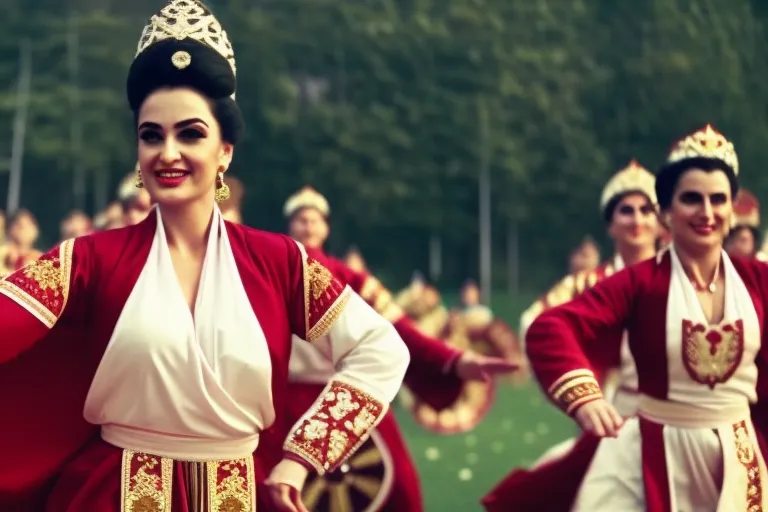If you're planning a trip to Georgia, then you're in for a treat. Georgia is a country with a rich cultural heritage, and its traditional music and dance are an essential part of it. Georgian traditional music and dance are unique in their own way and have been influenced by various cultures throughout history. In this guide, we'll explore Georgian traditional music and dance, its history, and its significance in Georgian culture.
Georgian Traditional Music
Georgian traditional music is a blend of various cultural influences, including Persian, Ottoman, and Russian. It is characterized by its unique polyphonic structure, which means that multiple melodies are sung simultaneously. Georgian traditional music is performed by a group of singers, usually men, and is accompanied by traditional instruments like the chonguri, panduri, and doli.
History of Georgian Traditional Music
The history of Georgian traditional music dates back to the 5th century, when Christianity was introduced to Georgia. The Georgian Orthodox Church played a significant role in the development of Georgian music, and many of the traditional songs are religious in nature. Georgian music was also influenced by the Persian and Ottoman Empires, which ruled over Georgia at different times.
During the Soviet era, Georgian traditional music faced some challenges due to the Soviet government's attempts to suppress traditional culture. However, the Georgian people continued to preserve their traditional music, and it has now regained its popularity.
Types of Georgian Traditional Music
Georgian traditional music can be classified into several types, including:
-
Chakrulo: This is a traditional Georgian song that was included in UNESCO's list of Masterpieces of the Oral and Intangible Heritage of Humanity in 2001. It is characterized by its powerful and energetic vocals and is usually performed by a group of singers.
-
Krimanchuli: This is a type of Georgian traditional music that is performed by a solo singer. It is usually a sad and melancholic song and is accompanied by the chonguri, a traditional Georgian stringed instrument.
-
Suliko: This is another popular Georgian traditional song that is known for its emotional and nostalgic lyrics. It is usually performed by a solo singer and is accompanied by the panduri, a traditional Georgian stringed instrument.
Popular Georgian Musicians
Georgian traditional music has produced many talented musicians over the years. Some of the most popular Georgian musicians include:
-
Anzor Erkomaishvili: He was a renowned Georgian composer and conductor who is credited with popularizing Georgian traditional music.
-
Nino Katamadze: She is a Georgian singer and songwriter who has gained international recognition for her unique style of music.
-
Eduard Shevardnadze: He was a Georgian politician who was also a talented musician and composer.
Georgian Traditional Dance
Georgian traditional dance is an essential part of Georgian culture and is known for its energetic and acrobatic movements. Georgian traditional dance is usually performed by a group of dancers, both men and women, and is accompanied by traditional music.
History of Georgian Traditional Dance
The history of Georgian traditional dance dates back to ancient times, and it has been influenced by various cultures throughout history. Georgian traditional dance was also influenced by the Georgian Orthodox Church, which played a significant role in the development of Georgian culture.
During the Soviet era, Georgian traditional dance faced some challenges due to the Soviet government's attempts to suppress traditional culture. However, the Georgian people continued to preserve their traditional dance, and it has now regained its popularity.
Types of Georgian Traditional Dance
Georgian traditional dance can be classified into several types, including:
-
Kartuli: This is a slow and graceful dance that is usually performed by a couple. It is characterized by its elegant and flowing movements and is often performed at weddings and other special occasions.
-
Khorumi: This is a fast and energetic dance that is usually performed by a group of male dancers. It is characterized by its acrobatic movements and is often performed at military parades and other patriotic events.
-
Acharuli: This is a lively and playful dance that is usually performed by a solo female dancer. It is characterized by its fast and intricate footwork and is often performed at festivals and other cultural events.
Popular Georgian Dancers
Georgian traditional dance has produced many talented dancers over the years. Some of the most popular Georgian dancers include:
-
Nino Ramishvili: She is a renowned Georgian choreographer and dancer who has gained international recognition for her unique style of dance.
-
Iliko Sukhishvili: He was a Georgian dancer and choreographer who founded the Georgian National Ballet, which is now known as the Sukhishvili Georgian National Ballet.
-
Nino Chkheidze: She is a Georgian dancer and choreographer who has gained international recognition for her unique style of dance.
Significance in Georgian Culture
Georgian traditional music and dance are an essential part of Georgian culture and have played a significant role in preserving the country's identity. Georgian traditional music and dance are often performed at weddings, festivals, and other cultural events, and they provide a sense of unity and belonging among the Georgian people.
Georgian traditional music and dance have also gained international recognition and have been included in UNESCO's list of Intangible Cultural Heritage of Humanity. This recognition has helped to promote Georgian culture and has increased interest in Georgian traditional music and dance around the world.
Conclusion
Georgian traditional music and dance are an essential part of Georgian culture and have been influenced by various cultures throughout history. Georgian traditional music is characterized by its unique polyphonic structure, while Georgian traditional dance is known for its energetic and acrobatic movements. If you're planning a trip to Georgia, make sure to experience Georgian traditional music and dance, as they are a vital part of the country's rich cultural heritage.
